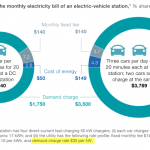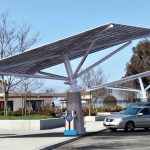Honda Makes Scooters With Hybrid Engines, Fuel Cells
Honda Motor Co (HMC) said it has built scooters powered by fuel cells and gasoline-electric engines, extending the technology for the first time to two-wheeled vehicles. The automaker developed a scooter with a fuel cell-power plant the size of a normal 125 cubic centimeter gasoline engine as well as a so-called hybrid two-wheeler with a 50cc engine, Honda President Takeo Fukui told reporters at the company's research center in Tochigi Prefecture, north of Tokyo.
A Blue-chip Clean Car Stock
One of the criticisms I often hear about cleantech is that, as an asset class, it is too risky and volatile for the average investor. That is a misconception Tom attempted to dispel a few months ago with his Blue-Chip Alternative Energy Portfolio. In fact, some of the most interesting work in cleantech and alternative energy is currently being conducted by large companies. A Clean Car Pick Last year, we told you about a report on investing in clean automotive. We have some interesting follow-up information on one of the companies discussed in that report. ...
BYD Stalled Despite Japanese Carmakers’ Woes in China
Doug Young BYD's G3 at the Shenzen High -Tech Fair in 2009. BYD needs more exciting new products to thrive despite Chinese buyers spurning Japanese auto brands. Photo credit: Brücke-Osteuropa. The prognosis isn't looking good for Japanese car brands in China, with Honda (Tokyo: 7267) becoming the latest predictor that the gloom plaguing Japan's big 3 automakers could last into next spring and perhaps even longer. That looks like bad news for not only Honda, Toyota (Tokyo: 7203) and Nissan (Tokyo: 7201), but also their Chinese...
Hydrogen Fuel Is Not Dead
John Lounsbury With the furor over the potential for hybrid, plug-in hybrid and all-electric cars recently, one might think the hydrogen car was dead. Nothing could be further from the truth. Feasibility at an affordable price appears to be established and market availability of hydrogen powered cars may come sooner than you think. Many issues remain to be addressed and this article will try to cover them. The problems to be overcome are not insurmountable, but are also not trivial. These problems include the economics of hydrogen production, transportation, distribution and...
EV Fast Charging Disincentives
by Daryl Roberts
DC Fast Chargers (DCFCs) and Tesla superchargers are a key element in electric vehicle (EV) charging infrastructure that could facilitate wider adoption of EVs by enabling recharging that comes to resemble the time currently taken for gas station stops, and thereby reducing “range anxiety” for drivers.
However, the pricing structure for electrical costs incurred at commercial DC fast chargers is currently prohibitive, because it includes a special fee called a “demand charge”. Rate design in a number of states includes this additional charge, based on the “peak rate” on electric power consumed in kW. In New York,...
Will We Have Too Much Generation for Renewables?
Too Many Brownies Before Dinner "When you feed your kid six brownies before dinner, you can't expect him to eat the salad, no matter how good it is." So says Leslie Glustrom, a long term renewable energy advocate. This is her metaphor for why Xcel Energy (NYSE: XEL) has been reluctant to pursue Demand Side Management (DSM) and renewable energy projects in Colorado as they have been in Minnesota. Because Xcel is currently constructing 500 MW of new coal-fired generation, and they are also interested in a 300-350 MW IGCC plant by 2013, they may have little demand for...
Compared to what: the low-down on alt energy subsidies
For now, electrics have won a fan base, but bio seems to be doing a better job of advancing the technology, reducing or eliminating tax credits, and giving customers more power of choice when it comes to selecting a car. The reason – bio-based is more affordable, and generally more infrastructure-compatible.
Battery-powered Locomotives – Compellingly Green Economics
John Petersen For the last two years I've been paying increasingly close attention to trailblazing work by Norfolk Southern (NSC) in the field of battery-powered locomotives. My interest was piqued in June of 2010 when Norfolk Southern hired Axion Power International (AXPW.OB) to develop a battery management system that would allow rail locomotives to run on battery power and recharge their batteries through regenerative braking. I believed the decision was positive news for Axion because nobody hires a battery manufacturer to design a BMS for somebody else's product. My enthusiasm was tempered, however, by knowing that an earlier...
Electric Cars and the Fixed Cost Conundrum
John Petersen Later this month, Tesla Motors plans to launch its initial public offering and sell about 12% of the company for $200 million. If the IPO is successful, Tesla's stock will trade on the Nasdaq Stock Market (TSLA) and its initial market capitalization will be roughly $1.5 billion. Since the IPO has spawned a series of analytical articles from better writers, I'll avoid the temptation to analyze the deal terms and focus on product issues instead. Like their cars, Tesla's IPO will undoubtedly attract vanity investors, the philosophically committed and the mathematically challenged. The more cautious element...
ELBC 2010 – Automakers Discuss Their Battery Requirements For Stop-Start Systems
John Petersen Last week I spent three days at the 11th European Lead Battery Conference in Istanbul where I learned that I've been far too conservative in earlier articles that discuss the likely impact of stop-start idle elimination systems on the battery sector. To put things in perspective, the 10th ELBC in 2008 had 500 participants and two papers on stop-start systems. The 11th ELBC in Istanbul had 700 participants and 15 papers on stop-start, including three from major automakers. The stop-start papers took a full day of the 2-1/2 day conference program. The high-level overview...
New Arotech Technology Allows Electric Bus to Run on Commercially Available Zinc
Arotech Corporation (ARTX) announced today that its Electric Vehicle unit has developed technology that will allow its zinc-air batteries to use commercially available zinc, eliminating the need for the special dendritic zinc used to date. Arotech's technological breakthrough for utilizing readily available zinc will boost commercialization plans for the zinc-air hybrid bus, which until now required heavy investments in zinc producing infrastructure.
UQM Technologies Receives Contract From the U.S. Army to Develop Advanced Vehicle Propulsion Motor
Unique Mobility Inc (UQM) announced that it has received a contract from the U.S. Army's Tank Automotive and Armaments Command (TACOM) to develop an advanced vehicle propulsion motor for application as a wheel mounted electric propulsion system for hybrid electric combat vehicles being developed under the Army's Future Combat Systems (FCS) program. The one year development effort will focus on the validation of a proprietary new design for a permanent magnet electric motor that has the potential to triple the torque capability compared to existing UQM(R) propulsion motors. Army funding for the cost-share project is $242,548 or 77...
The Holdings of the Powershares Global Progressive Transport Portfolio ETF (PTRP)
Tom Konrad, CFA I included the Powershares Global Progressive Transport Portfolio (PTRP) as an investment option instead of three stocks in my Ten Clean Energy Stocks for 2010, as part of a simplified portfolio for small investors wanting to minimize costs by making fewer trades. The other Exchange Traded Fund I used in this way was the First Trust Nasdaq Clean Edge Smart Grid Infrastructure Index Fund (GRID). I took a look at the holdings of the Smart Grid ETF here, and they are not exactly what you would expect from the name. Since it makes sense to know...
BYD Profit Sputters
Doug Young The number 94 seems to have special meaning for BYD (HKEx: 1211; 002594; OTC:BYDDF), the struggling car maker backed by billionaire investor Warren Buffett, which has just reported some preliminary data that show its profit last year fell 94 percent as it failed reverse its sharp decline of the last 2 years. But perhaps more alarming, this new data show the company's operations fell into the loss column in the last 3 months of 2012, even though it technically remained profitable overall due to strong government support. That means that 2013 could continue to...
How Growing HEV Markets Will Impact Battery Manufacturing Revenues
John Petersen For the last three weeks I've been writing about why rising oil prices, tightened CO2 emission standards in Europe and accelerated CAFE standards in the U.S. will combine to foster rapid implementation of hybrid electric vehicle (HEV) technology in the automotive industry and result in huge revenue increases for all automotive battery manufacturers. These articles have generated record numbers of comments and questions from readers that want a clearer understanding of what the rapidly changing demand picture means for battery investors. While I generally try to avoid revenue forecasts because they require pricing assumptions...
Envision’s Off Grid Electric Vehicle Charging Stations
In a recent discussion about the extent to which Demand Charges are an impediment to development of DC fast chargers EV Fast Charging Disincentives, the solutions explored included primarily a) regulatory reform of the rate design & b) technology solutions involving battery based peak shaving.
A 3rd solution could be added, for strategies involving charging with behind-the-meter renewable generation. Solar carports can offer such a solution, with various configurations involving batteries sized to support L2 chargers. Most of the PV carports are grid-connected but can be islanded. I recently discovered a system that is completely off-grid. So far most of the carports...




